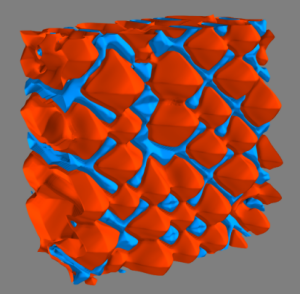
László Rátkai1, Gyula Tóth2, László Környei3, Tamás Pusztai1, László Gránásy1,4
1Institute for Solid State Physics and Optics, Wigner Research Centre for Physics, P.O. Box 49, Budapest H-1525, Hungary
2Department of Mathematical Sciences, Loughborough University, Loughborough, Leicestershire, LE11 3TU, U.K.
3Department of Mathematics and Computational Sciences, Széchenyi István University, Győr 9026, Hungary
4BCAST, Brunel University, Uxbridge, Middlesex, UB8 3PH, United Kingdom
A simple phase-field model is used to address anisotropic eutectic freezing on the nanoscale in two (2D) and three
dimensions (3D). Comparing parameter-free simulations with experiments, it is demonstrated that the employed
model can be made quantitative for Ag-Cu. Next, we explore the effect of material properties, and the conditions
of freezing on the eutectic pattern. We find that the anisotropies of kinetic coefficient and the interfacial free
energies (solid-liquid and solid-solid), the crystal misorientation relative to pulling, the lateral temperature
gradient, play essential roles in determining the eutectic pattern. Finally, we explore eutectic morphologies, which
form when one of the solid phases are faceted, and investigate cases, in which the kinetic anisotropy for the two
solid phases are drastically different.


